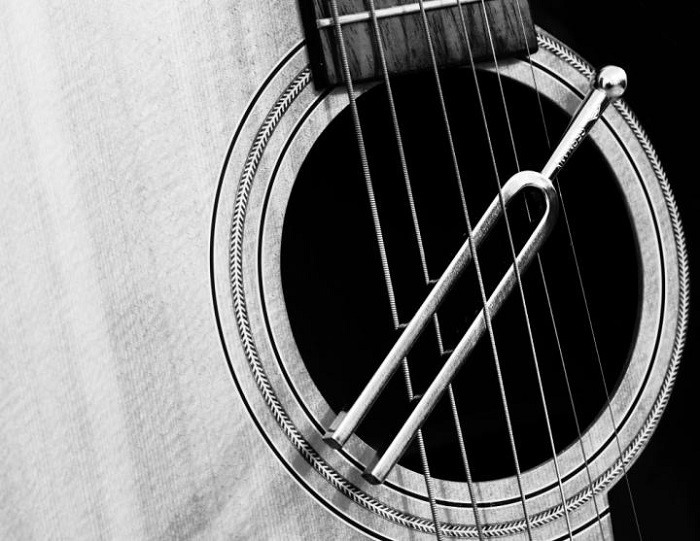An international research team has proven it is possible to switch the fundamental property of electrons from an excited state to a relaxed state in a very precise, controlled, and most importantly, repeatable manner.
This achievement came by way of a specially designed device that served as a microwave “tuning fork”.

Expounding upon the discovery a bit more, the team found that they could dramatically increase the coupling of microwaves in a specially designed superconducting cavity to a fundamental electron property called “spin”.
Specifically, they zapped a specially designed silicon material with microwaves and found that in doing so, they could rapidly change the electron spins from an excited state to a relaxed, ground state by causing the electrons to emit some energy in the form of photons.
Now, if these electrons were left alone, the spins would be unlikely to go back to a relaxed state, let alone emit a photon. Referred to as the “Purcell effect”, it happens at a rate of about once every 10,000 years. The team here has successfully demonstrated an accelerated relaxation of electron spins at a rate of about once per second.
“It's like a juggler who throws the balls up, and the balls come down 1,000 times faster than normal, and they also emit a microwave flash as they drop,” explained Thomas Schenkel, a physicist in Berkeley Lab's Accelerator Technology and Applied Physics Division, who led the design and development of the silicon sample used in the experiment.
Getting into the details of the experiment a bit more, the team used a small sample of a highly purified form of silicon, implanted with a matrix of bismuth atoms; atop it, a superconducting aluminum circuit was deposited. Altogether, this created a high-quality resonant cavity that allowed for the aforementioned tuning of the microwaves.
At the start of the experiment, the electron spins of the bismuth atoms were flipped into the excited, “spin-up” state. The microwave cavity was then tuned to a particular resonance that coaxed the spins into emitting a photon while flipping back to a relaxed state. The specially designed cavity increased the number of states a photon can be emitted; this, in turn, greatly increased the decay rate for the electron spins in a very precise, very controlled manner.
It is worth pointing out that the large bismuth atoms embedded in the silicon provided the electrons with the unique spin properties that enabled the success of this particular experiment. Schenkel said the actual doping process, that is, implanting the bismuth atoms into the delicate silicon framework, was “like squeezing bowling balls into a lattice of ping-pong balls.”
“We did a new trick with silicon. People wouldn't expect you could squeeze anything new out of silicon,” Schenkel said. “Now we're looking into further improving bismuth-doped silicon and into tailoring the spin properties of other materials, and using this experimental technique for these materials.”
“Our results are highly significant for quantum information processing,” explained Patrice Bertet, a quantum electronics scientist at the French Atomic Energy Commission (CEA) who led the experiment. “Indeed, they are a first step toward the strong coupling of individual electron spins to microwave photons, which could form the basis of a new spin-based quantum computer architecture.”
John Morton, a professor at the London Center for Nanotechnology and co-author of the study, said, “Our ultimate aim is to find a link between quantum information that is fixed and quantum information that can be transported by photons.”
Per Bertet and Morton’s points, information today is stored as individual bits, either in the form of a one or a zero. Quantum computers, meanwhile, are capable of using a new bit called a qubit which, without turning this article into an expose on quantum mechanics, is capable of behaving as both a one and a zero. This capability is why quantum computers are believed to have so much potential — a coupled array of qubits would allow a computer to perform several calculations simultaneously. Controllable microwave photons, such as that which is described here, could work with the spins of electrons to move information exponentially faster, and with incredible accuracy.
“What we need now is ways to wire up these systems — to couple these spins together,” Morton said. “We need to make coupled qubits that can perform computations.”
Looking ahead, the team hopes to enhance the performance of the materials; this can be achieved by improving upon the doping process so it is less damaging to the silicon lattice. Additionally, the group believes the implantation process could be adjusted to better produce regularly spaced arrays of individual electron spins that would be more useful for quantum computing (as opposed to the concentrated collection of electron spins described in this study).
“We are now doing experiments on processing this and other materials at higher temperature and pressure with nanosecond ion pulses at NDCX-II, one of the accelerators here at Berkeley Lab,” Schenkel said. “There are indications that it will improve the overall spin quality.”
Beyond the advancement of quantum computing, this discovery could prove useful in boosting the sensitivity of things like nuclear magnetic resonance spectroscopy and dynamic nuclear polarization; it can also be used as a means for shortening experimental times by providing researchers the ability to manipulate spin properties.
“You need a way to reset spins — the ability to cause them to relax on demand to improve the rate at which you can repeat an experiment,” Morton said.
Bertet added that it could very well be possible to further accelerate the electron-flipping behavior to below 1 millisecond, compared to the 1-second rate in the latest results.
“This will then open the way to many new applications,” he said.
To learn more, download the team’s paper, entitled Controlling spin relaxation with a cavity, which was published in the journal “Nature.”
Via Berkeley Lab
Advertisement
Learn more about Electronic Products Magazine





